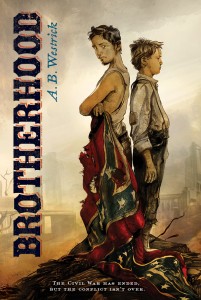

A.B. Westrick here. I’m the author of BROTHERHOOD (Penguin Young Readers). If you’d told me a few years ago that I’d be writing and speaking about GID, I might have said, “Huh? GID, what? Guided Inquiry Design? You must have me confused with someone else. I don’t know what you’re talking about.”
 Now it’s 2016, and boy am I singing a new tune. I wish my teachers had used Guided Inquiry when I was growing up. I’d especially have welcomed it in history classes, which I generally found to be dreadful. Having to memorize dates and names of dead white guys and strategies that won or lost wars? Spare me. Please.
Now it’s 2016, and boy am I singing a new tune. I wish my teachers had used Guided Inquiry when I was growing up. I’d especially have welcomed it in history classes, which I generally found to be dreadful. Having to memorize dates and names of dead white guys and strategies that won or lost wars? Spare me. Please.
But I’m not going to post here about history, not really. Only kind-of. I write fiction—not the first outlet that comes to mind when educators talk about GID. But as it turns out, my novel inspired two middle school librarians and a 7th grade social studies/language arts teacher at Carver Middle School in Chester, VA, to plan a dynamic GID unit. Next month—on June 25, 2016—during the AASL Awards session at the national ALA conference in Orlando, that team is going to receive the Collaborative School Library Award. Go, team!
So, how did it come about that fiction inspired their GID unit? Well. Read on. For today, I hope to make you curious, just as GID encourages you to do with students during the “Open” stage. Check out my book trailer (only 53 seconds long):
And if you want the full experience of the “Open” stage of the Carver Middle School unit, read chapter one of BROTHERHOOD. (Here it is at Amazon.) I hope I’ve piqued your curiosity!
Tomorrow I’ll tell you about the “Immerse” stage and the rest of this GID unit, but if you’d like a sneak-peek, check out this “Blendspace” page. (I also link to the “Blendspace” page from the “Teachers” page of my website.) The Carver team posted everything there, including parental permission forms.
In my next post I’ll go into detail, and you’ll see that the unit was rather involved. The students loved it. But when it occurred to me that some schools wouldn’t have the resources to do the whole unit, I developed a scaled-down version that’s essentially a writing workshop based on GID. And history. Yes, I have to come back to history. (My book is historical fiction.)
 In my third post, I’ll talk about the writing workshop, and you’ll see that it’s not about teaching history as much as it’s about getting students excited to ask their own questions about history. What I especially love about GID is the way it encourages students to lean how to learn. More tomorrow…
In my third post, I’ll talk about the writing workshop, and you’ll see that it’s not about teaching history as much as it’s about getting students excited to ask their own questions about history. What I especially love about GID is the way it encourages students to lean how to learn. More tomorrow…